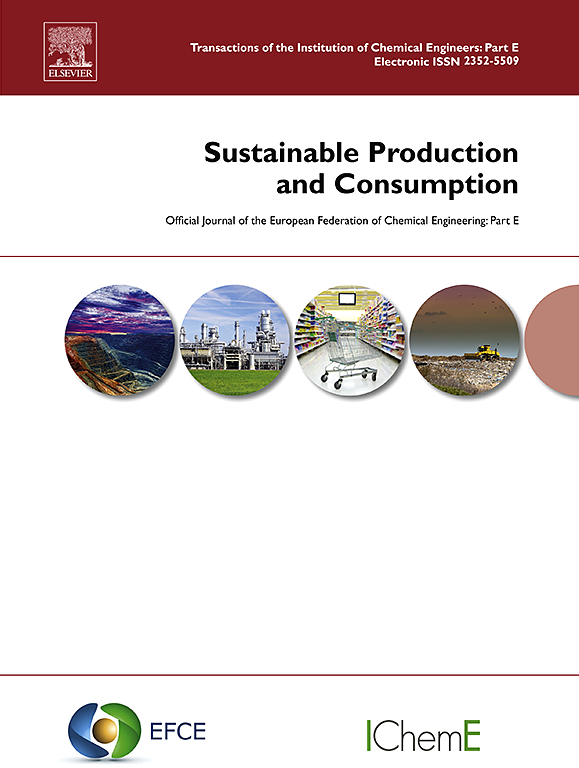缓解措施组合对指导中国作物-牲畜生产系统实现净零排放的贡献
IF 9.6
1区 环境科学与生态学
Q1 ENVIRONMENTAL STUDIES
引用次数: 0
摘要
农业排放的温室气体(GHG)占粮食系统排放总量的 50%以上,在实现气候目标方面发挥着关键作用。农业如何以及在多大程度上减少温室气体排放,是否能实现净零排放,仍有待进一步揭示。我们采用生命周期和情景分析方法,以单位作物栽培面积和一头牲畜为功能单元,评估了中国作物-畜牧业综合生产系统在实施一系列减排措施后的剩余排放量。结果显示,综合系统的生命周期温室气体净排放量为 1.4219 亿吨二氧化碳当量。在情景 3 中,针对秸秆利用的综合措施实现的减排量最大,为 2.7042 亿吨二氧化碳当量,其次是针对粪肥管理的措施,为 2.063 亿吨二氧化碳当量。净剩余排放量大幅下降至 2.4135 亿吨二氧化碳当量,这是由于通过二氧化碳捕获的生物能源生产实现了净负排放(-3.983 亿吨二氧化碳当量),同时能源和材料生产以及能源使用也产生了排放(2.9717 亿吨二氧化碳当量),肠道发酵、粪便管理和水稻种植也产生了难以消减的直接排放(3.4247 亿吨二氧化碳当量)。中国农作物-畜牧业生产系统要实现进一步减排,甚至是净零排放和负排放,将在很大程度上取决于向低碳能源系统过渡,以及结合二氧化碳捕集扩大农业废弃物变能源利用。本文章由计算机程序翻译,如有差异,请以英文原文为准。
Contributions of a mitigation measure portfolio to directing Chinese crop-livestock production system towards net-zero emissions
Agriculture contributes over 50% of greenhouse gas (GHG) emissions within the food system and plays a key role in reaching the climate target. How and to what extent agriculture can reduce GHG emissions, and whether it can achieve net-zero emissions, remain to be further uncovered. Applying a life cycle and scenario analysis approach with the functional units defined as unit crop cultivated area and one head of livestock, we assess the residual emissions of the integrated crop-livestock production system in China after implementing a portfolio of mitigation measures. The results show that the life cycle net GHG emissions in the integrated system is 1142.19 Million tons (Mt) of carbon dioxide equivalent (CO2-eq). In scenario 3, the combined measures targeting straw utilization achieve the greatest reduction of 270.42 Mt CO2-eq, followed by measures implemented for manure management at 206.30 Mt CO2-eq. The net residual emissions significantly drop to 241.35 Mt CO2-eq, resulting from the net negative emissions achieved through bioenergy production with CO2 capture (−398.30 Mt CO2-eq), alongside emissions from energy and material production, and energy use (297.17 Mt CO2-eq), as well as hard-to-abate direct emissions (342.47 Mt CO2-eq) from enteric fermentation, manure management, and rice cultivation. Achieving further emission reductions, even net-zero and negative emissions in Chinese crop-livestock production system will strongly depend on transitioning to low-carbon energy system and expanding agricultural waste-to-energy utilization combined with CO2 capture.
求助全文
通过发布文献求助,成功后即可免费获取论文全文。
去求助
来源期刊

Sustainable Production and Consumption
Environmental Science-Environmental Engineering
CiteScore
17.40
自引率
7.40%
发文量
389
审稿时长
13 days
期刊介绍:
Sustainable production and consumption refers to the production and utilization of goods and services in a way that benefits society, is economically viable, and has minimal environmental impact throughout its entire lifespan. Our journal is dedicated to publishing top-notch interdisciplinary research and practical studies in this emerging field. We take a distinctive approach by examining the interplay between technology, consumption patterns, and policy to identify sustainable solutions for both production and consumption systems.
 求助内容:
求助内容: 应助结果提醒方式:
应助结果提醒方式:


